
The Most Noble Order of the Garter is an order of chivalry founded by Edward III of England in 1348. The most senior order of knighthood in the British honours system, it is outranked in precedence only by the decorations of the Victoria Cross and the George Cross. The Order of the Garter is dedicated to the image and arms of Saint George, England's patron saint.
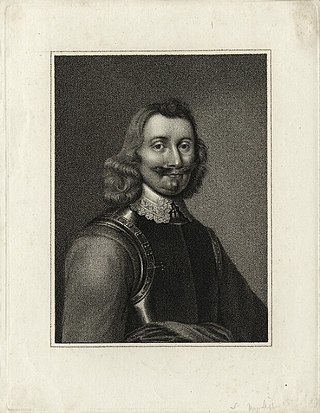
Philip Skippon supported the Parliamentary cause during the English Civil War as a senior officer in the New Model Army. Prior to the war he fought in the religious wars on the continent. During the Interregnum he was a member of Parliament, an active soldier and on occasions a government administrator.

Sir William Dugdale was an English antiquary and herald. As a scholar he was influential in the development of medieval history as an academic subject.

The Lord Warden of the Cinque Ports is a ceremonial official in the United Kingdom. The post dates from at least the 12th century, when the title was Keeper of the Coast, but may be older. The Lord Warden was originally in charge of the Cinque Ports, a group of five port towns on the southeast coast of England that was formed to collectively supply ships for The Crown in the absence at the time of a formal navy. Today the role is a sinecure and an honorary title, and fourteen towns belong to the Cinque Ports confederation. The title is one of the higher honours bestowed by the Sovereign; it has often been held by members of the Royal Family or prime ministers, especially those who have been influential in defending Britain at times of war.
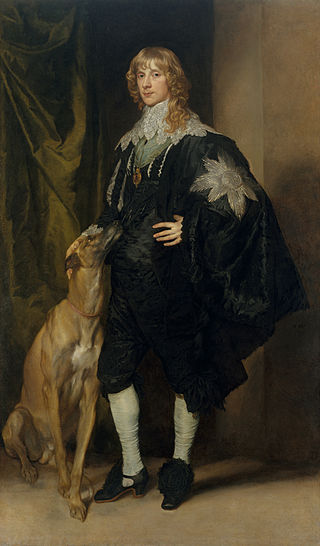
James Stewart, 1st Duke of Richmond, 4th Duke of Lennox KG, lord of the Manor of Cobham, Kent, was a Scottish nobleman. A third cousin of King Charles I, he was a Privy Councillor and a key member of the Royalist party in the English Civil War. In 1641–42, he served as Lord Warden of the Cinque Ports. He spent five months in exile in 1643, returning to England to defend the city of Oxford for the king.

Montagu Bertie, 2nd Earl of Lindsey, KG, PC, was an English soldier, courtier, and politician who sat in the House of Commons between 1624 and 1626. He was created Baron Willoughby de Eresby by writ of acceleration in 1640 and inherited the peerage of Earl of Lindsey in 1642. He fought in the Royalist army in the English Civil War.

Garter Principal King of Arms is the senior king of arms and officer of arms of the College of Arms, the heraldic authority with jurisdiction over England, Wales and Northern Ireland. The position has existed since 1415.

Norroy and Ulster King of Arms is the provincial King of Arms at the College of Arms with jurisdiction over England north of the Trent and Northern Ireland. The two offices of Norroy and Ulster were formerly separate. Norroy King of Arms is the older office, there being a reference as early as 1276 to a "King of Heralds beyond the Trent in the North". The name Norroy is derived from the Old French nort roy meaning 'north king'. The office of Ulster Principal King of Arms for All-Ireland was established in 1552 by King Edward VI to replace the older post of Ireland King of Arms, which had lapsed in 1487.
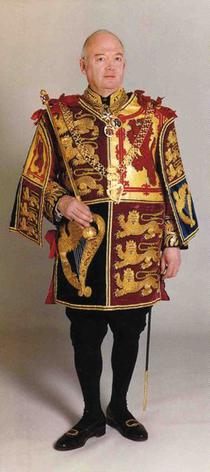
John Philip Brooke Brooke-Little was an English writer on heraldic subjects, and a long-serving herald at the College of Arms in London. In 1947, while still a student, Brooke-Little founded the Society of Heraldic Antiquaries, now known as the Heraldry Society and recognised as one of the leading learned societies in its field. He served as the society's chairman for 50 years and then as its president from 1997 until his death in 2006.
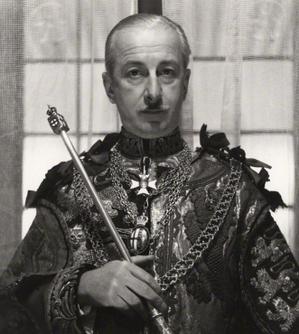
Sir George Rothe Bellew,, styled The Honourable after 1935, was a long-serving herald at the College of Arms in London. Educated at the University of Oxford, he was appointed Portcullis Pursuivant in 1922. Having been Somerset Herald for 24 years, he was promoted to the office of Garter Principal King of Arms in 1950, the highest heraldic office in England and Wales. He served in that capacity until his resignation in 1961. As Garter, Bellew oversaw the funeral of George VI, proclaimed the late King's daughter, Elizabeth II, as Queen and took a leading role in the organisation of her Coronation in 1953. After his retirement, Bellew was Secretary of the Order of the Garter and Knight Principal of the Imperial Society of Knights Bachelor. He lived for many years at Dower House in Old Windsor, Berkshire, but later moved to Farnham and died in 1993, aged 93.
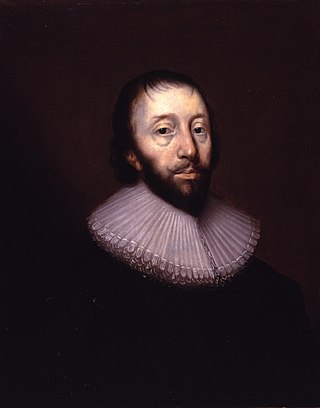
Sir Dudley Digges was an English diplomat and politician who sat in the House of Commons between 1610 and 1629. Digges was also a "Virginia adventurer," an investor who ventured his capital in the Virginia Company of London; his son Edward Digges would go on to be Governor of Virginia. Dudley Digges was responsible for the rebuilding of Chilham Castle, completed in around 1616.
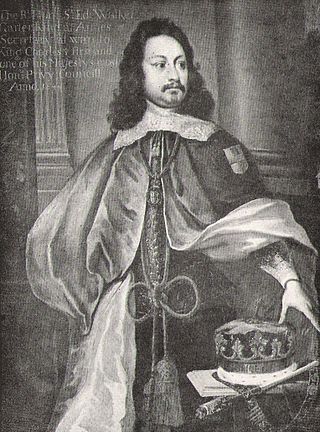
Sir Edward Walker was an officer of arms and antiquarian who served as Garter King of Arms.
John Philipot was an officer of arms at the College of Arms in London and a politician who sat in the House of Commons from 1628 to 1629. Though he successfully attained the position on Somerset Herald of Arms in Ordinary, he is best known for his production of a roll of arms of the Lord Wardens of the Cinque Ports.
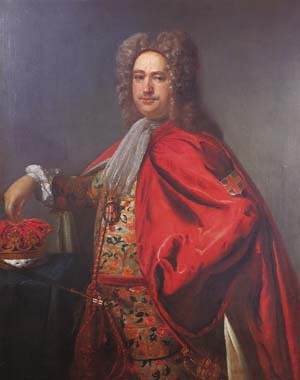
John Anstis was an English officer of arms, antiquarian and politician who sat in the House of Commons between 1702 and 1722. He rose to the highest heraldic office in England and became Garter King of Arms in 1718 after years of political manoeuvring.
Sir John Gordon, 1st Baronet was a Scottish Royalist supporter of Charles I during the Wars of the Three Kingdoms. Gordon distinguished himself against the covenanters at Turriff, 1639, and joined Charles I in England. Created a baronet in 1642 for his services, he was excommunicated and forced to surrender by the Covenanters under Argyll at Kellie in 1644 and was subsequently beheaded for treason at Edinburgh.
Sir Edward Bysshe FRS (1615?–1679) was an English barrister, politician and officer of arms. He sat in the House of Commons variously between 1640 and 1679 and was Garter King of Arms during the Commonwealth period.
Sir Henry St George (1581–1644) was an English Officer of arms. He was the third son of the herald Sir Richard St George and his wife Elizabeth St John.
John Burroughs (1837–1921) was an American naturalist and nature essayist.
George Owen was a Welsh officer of arms, York herald from 1633.
William Ryley was an officer of arms at the College of Arms in London.













